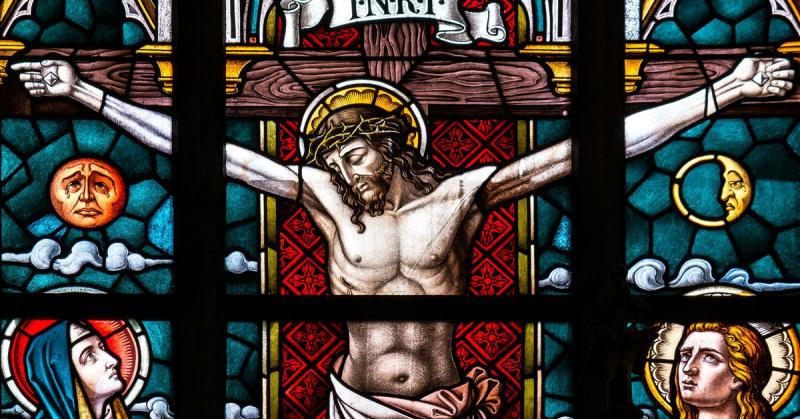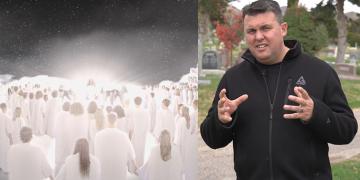You are here
Book of Mormon Central is in the process of migrating to our new Scripture Central website.
We ask for your patience during this transition. Over the coming weeks, all pages of bookofmormoncentral.org will be redirected to their corresponding page on scripturecentral.org, resulting in minimal disruption.
Enjoy images of the Holy Land as you visualize Jesus Christ's last hours with the following slideshow of photos by John W. Welch
The Power of Apostolic Eyewitness Testimony
We now turn to the often-asked question: Who killed Jesus? The answer is not simple, and we can now better appreciate that lots of people were involved in all of this, each in their various way.
To answer this question, we must reflect again on which of the four Gospels one should favor, for on this point in particular the different Gospels emphasize different answers to this question.
In giving weight to statements of all kinds, Latter-day Saints generally favor the words of the highest priesthood authority. In this case, that New Testament person would be the apostle John. Along with Peter and James, John the Beloved was one of the three highest ranking apostles. Matthew was one of the Twelve, but Mark and Luke were not.
Moreover, people most often find great credibility in the testimonies of eyewitnesses. It is not clear how Mark and Luke learned the details that they reported. Luke was clearly not present for any of the proceedings surrounding Jesus’ trial and death. It is true that Mark may have learned some things from Peter, but after the arrest of Jesus, Peter “followed [Jesus, being only] afar off” (Matt. 26:58); Peter stayed outside the door of Caiaphas’ palace, hoping and needing to remain unrecognized. The apostle Matthew would have been close to many of these events, but he never says so.
The apostle John, on the other hand, was personally present for the duration of these developments. John appears to have been the disciple who “went in with Jesus into the palace of the high priest” (John 18:15), right after the arrest in Gethsemane. And then in the Praetorium, John evidently heard the exchange between Jesus and Pilate, which John reports. John was also there at Golgotha when Jesus entrusted his mother Mary into his care (John 19:26–27). Of the spear thrust, John testified: “And he that saw it bare record [gives solemn testimony], and his [testimony] is true” (John 19:35). In this affirmation, John distinctively speaks of himself as the one who saw, claiming for himself special status. Latter-day Saints, therefore, take John’s witness seriously.
This is especially so because with John’s report of the trial of Jesus is supported and reinforced by the Book of Mormon. A key element in Latter-day Saint doctrine is the knowledge that the sacrifice of the Savior was promised and foreordained from before the foundation of this earth, as is taught in the words of Lehi, Benjamin, Abinadi, and Alma. Likewise, for the apostle John, the death of Jesus was a foregone conclusion from the beginning. It had to happen. It was supposed to happen. “For this cause came I into the world” (John 18:37).
John particularly wants his readers to understand that Jesus was not killed because of some offense against the Temple or its economy, as many people conclude (especially by giving preference to Mark). But here John is particularly interesting. Unlike Matthew and Mark, the apostle John does not have Jesus ever say either that he is able to or that he actually will destroy the Temple. Rather, John 2:19 reads, “[If you] destroy this temple, . . . in three days I will raise it up.”
People have also long puzzled over the distance that John puts between the cleansing of the Temple and the death of Jesus. For John, the cleansing occurs at the very beginning of Jesus’ ministry (see John 2:13–17), not the day after his Triumphal Entry into Jerusalem. Why does John place it there? One reason is to introduce from the beginning Jesus’ prophecy of his death and bodily resurrection. Another is to show Jesus working at an already cleansed temple, where he went often throughout his ministry.
Even in discussing the Synoptic accounts, it is something of a misnomer to speak of “the trial” of Jesus. There was a hearing of some kind, and perhaps an inquiry or attempted deposition, and then the voicing of an opinion of how things “appeared” (as the Greek reads in Matthew 26:66 and Mark 14:64). But it is hard to see any formal trial and verdict occurring in the early hours of that morning. Something different and much bigger was going on here.
Latter-day Saints understand that Jesus, the Holy One, was innocent of any crime. Indeed, in John’s good news, Jesus was not convicted of anything by Pilate. In John, rather than actually convicting Jesus after his arrest, the Chief Priests simply move ahead on the strength of the prior decision of the Sanhedrin in John 11:50 that Jesus should be put to death, on the ground that it would be better for one man to perish than for the entire nation to be destroyed.
This seems particularly consonant with another important revelation found in the Book of Mormon. Nephi prophesied: “And the world, because of their iniquity, shall judge him to be a thing of naught; wherefore they scourge him, [smite him and spit upon him] and he suffereth it, … because of his loving kindness and his long-suffering towards [all] the children of men” (1 Nephi 19:9).
Responsibility of the Chief Priests
If one needs to find the precipitating culprit in all of this, the prime and persistent movers in the final actions against Jesus were probably only the members of the relatively small group of Chief Priests under the control of the High Priest Caiaphas. They were the most powerful and best known officials of Jerusalem. An interesting pattern emerges by carefully examining every reference to these Chief Priests, as found in the chart that was introduced in the discussion on Day 1 above.
In particular, it was the Chief Priests and Scribes whom Herod asked about the birthplace of the Messiah. When Jesus prophesied about his death in Matthew 16:21, he mentioned only the Chief Priests, Elders, and Scribes as being involved. It was the Chief Priests and Elders who in the Temple questioned Jesus about his authority. The Chief Priests alone sought Jesus’s death after the raising of Lazarus. Judas betrayed Jesus to the Chief Priests. The Chief Priests alone demanded Jesus’s death before Pilate in Mark 15:3; and in the end, it was the Chief Priests who wanted the placard on the cross to read, “He said, I am King of the Jews” (John 19:21).
Fourteen times in the Gospels and four times in Acts, the Chief Priests act alone against Jesus or against his disciples. Eighteen other times, they act together with the Elders, rulers, captains, or the Sanhedrin. Twenty-one times they are associated with the Scribes. Clearly the Chief Priests and these associates of theirs are the main driving force behind the arrest and execution of Jesus. The Pharisees often debated Jesus and were verbally denounced by him, but they are mentioned much less often, and they lacked the political muscle of the Sadducean Chief Priests, whose party had a solid majority in the Sanhedrin. It is not hard to see this small group of Chief Priests as the one consistent force that agitated and militated against Jesus and his disciples. Their crowd was not large. Certainly the crowd outside Pilate’s administrative office in Jerusalem did not include all the Jews.
This subtle but important point is consistent with a significant passage in the Book of Mormon. In 2 Nephi 10:5 it clearly says that it would be “because of priestcrafts [in other words, because of a group of priests interested in trafficking in religion and politics for power and money] and [because of] iniquities, [that] they at Jerusalem will stiffen their necks against him, that he be crucified.” The Book of Mormon clearly does not implicate or condemn all Jews.
In this regard, we should also remember the testimony of Paul. As a student of Gamaliel, Paul would have been well informed about legal events in Jerusalem, and he adds an important corroboration to this Book of Mormon position. The words in 1 Thessalonians 2:14–15 speak of Jews who killed Jesus. The punctuation in this verse is crucial. Should it read “the Jews who killed Jesus,” with no comma between “Jews” and “who” (thus meaning “the particular Jews who killed Jesus”), or should it read “the Jews [comma] who killed Jesus” (thus grammatically saying that “the Jews [all of them] killed Jesus”)? This comma question involves the most famous punctuation mark in the world; when a comma is inserted here, it is known as the “antisemitic comma,” because it operates grammatically to blame all Jews. But based on the Greek construction of this sentence, no punctuation mark should be there, and thus Paul spoke here only of “those particular Jews who killed Jesus.”
Indeed, many Jews accepted Jesus. Peter was a Jew. Mary was a Jew. John was a Jew. Most of Jesus’s early disciples were Jews. Those in the crowds on Palm Sunday were no doubt all Jews. The number of those who rejected Jesus was far fewer. On this point, Pope Benedict XVI has similarly said, “In John’s Gospel this word [the Jews] has a precise and clearly defined meaning: [John] is referring to the Temple aristocracy.”1
Still, No One to “Blame”
Finally, especially for John, Jesus was in full control from the very beginning to the very end. At the outset of his ministry, Jesus spoke of his death even to prominent Jewish leaders and others outside his circle of disciples. Speaking to Nicodemus, Jesus said, “Even so must the Son of man be lifted up” (John 3:14). Consistently throughout his writing, John reports the death of Jesus with Jesus knowing exactly what was required to carry out the plan. When his hour had come, Jesus knew and “bowed his head, and handed over his spirit” (according to the Greek in John 19:30). I find it significant that this same word is used three times in the story: when Judas betrayed or handed Jesus over to his arresters; when the Jews handed Jesus over to Pilate; and when Jesus handed over his spirit to God. For John, we must never forget that it is God who is voluntarily, purposefully, and knowingly dying as planned.
With this as background, and knowing that much more work still remains to be done, we can now cautiously offer an answer to the question, Who was responsible for the death of Jesus? For John and for Latter-day Saints it would appear that, in reality, the whole world killed Jesus. As Nephi also prophesied, the whole “world” would kill their God (1 Nephi 19:9). And if it is so that everyone was effectively responsible, then, in an important sense, no one was responsible or to blame. And, even if someone specific were to blame, that would seem quite irrelevant for John, the apostle of love.
Of course, iniquity played its part. But, ironically, the Greeks, for whom the gods could be found just about anywhere, were quite accepting of miracle workers as well as the idea that some mortals might have existed who were partially of divine parentage.
The Jewish legal system, however—with its prohibitions against idolatry and polytheism—effectively made the Jews (as the Book of Mormon says) the only ancient culture on earth that could have worried enough about miraculous conduct to have reacted with such categorical hostility and to have “stumbled” against the very presence of their God in their midst, as Jacob says (Jacob 4:15). In 2 Nephi 10:3–6, Jacob wrote that it was “expedient”—meaning pragmatically effective, “tending to promote some good end or desired purpose, expeditiously, quickly, and profitably”—that Jesus “should come among the Jews,” for “thus it behooveth [or was fittingly necessary for] our God.”
Jacob identified that Old World location as “the more wicked part of the world,” with “more wicked” being a comparative between two places. From Jacob’s point of view, the question was whether Jesus should come to the Old World Lehi had left or to the New Land of Promise. His answer was, to the Old, for its inhabitants would be more wicked than Lehi’s posterity. He further explains, “And there is none other nation on earth that would crucify their God.” I would hasten to emphasize that Jacob’s statement views this conduct in collective terms. It does not infer that all individuals in that body necessarily agreed with their national leaders on this action. Thus, it should also be noted that Jacob’s broad condemnation of the Jews of Jesus’s day should not be seen as an endorsement of antisemitism. Indeed, the Book of Mormon explicitly prohibits the persecution of the Jews (see 3 Nephi 29:8; cf. 2 Nephi 29:4–5).
Continuing on, Jacob concludes, “For should the mighty miracles be wrought among other nations they would repent, and know that he be their God” (2 Nephi 10:4). Indeed, accepting Jesus might have been easier for people in other cultures that were more accepting of miracles and divinely embodied beings, but then the promises made to that nation, as well as the need for the death of the Redeemer who alone could descend below all things, including death, and then rise to be eternally in and through all things, would go unfulfilled, unrealized, and frustrated.
Ultimately there may well have been grievous miscarriages of justice in the treatment of Jesus, but Latter-day Saints have many reasons not to think of the death of Jesus primarily in that pathetic way. Neither the apostle John nor Lehi’s son Jacob wanted people to think of the death of Jesus that way. Latter-day Saints do not see Jesus as a victim but as the victor. His death was supposed to happen. It was not a mistake. It had to happen. It was agreed to happen.
And perhaps for this very reason, God in his mercy does not come out and place blame on any single person or any particular group of people. Perhaps this is why the writers of the New Testament Gospels left things so ambiguous. They could have been much clearer about why Jesus was killed and about who killed Jesus if they had wanted to be. But that was not their point. Even in the case of Judas, we do not know what really motivated him. Was he intending or hoping for a different outcome? Things certainly did not turn out the way he expected.
In the final analysis, most people involved had no idea what was really happening and what they were actually doing. Speaking seven weeks later to those very people in Jerusalem who had killed “the Prince of life,” Peter said: “I wot [I know] that through ignorance ye did it, as did also your rulers” (Acts 3:15, 17, emphasis added).
Jesus forgave people as he hung on the cross, forgiving whom he willed and would. And of Latter-day Saints, the Lord requires that we, on our part, should “forgive all” people (D&C 64:10). Whereas God will judge, we are to “judge not” (Matthew 7:1; 3 Nephi 14:1). Placing blame is not part of this picture.
Masterfully understating all that had happened and all that He had suffered, all that Jesus humbly said as he spoke out of the darkness to the Nephites was this: “I came unto my own, and my own received me not” (3 Nephi 9:16).
Let us not forget that we also reject and crucify Jesus anew whenever we partake of the world and its dark judgmental ways.
By reflecting carefully, cautiously and clearly on the events and causes leading up to the death of Jesus, one may more surely agree, and believe, and know that he is indeed the Son of God, of whom the Book of Mormon and all the holy prophets have ever testified.
In his first general epistle, the apostle John concluded: “And we know that the Son of God is come,” for “we have heard, . . . we have seen with our eyes, . . . and our hands have handled,” “and he hath given us an understanding, that we may know him that is true, and we are in him that is true, even in his Son Jesus Christ. This is the true God, and eternal life” (1 John 1:1; 5:20).2 Indeed, many people, on at least 20 occasions, likewise have seen the resurrected Son of God and have so testified. The following, final chart conveniently details these witnesses, including their names (as far as are known), scripture references, date or time, place of appearance, a summary of what transpired, and other items of interest. Combining all these very personal appearances together with the times when the resurrected Lord appeared more publically to 500 brethren in the Old World (1 Cor. 15:6), to 2,500 men, women, and children in the Nephite city of Bountiful (3 Nephi 1:1, 15; 17:15), and additionally in modern times to Joseph Smith and others in New York and Kirtland, Ohio, the Resurrection becomes one of the most witnessed miracles of all the supernal wonders performed by the Lord Jesus Christ.
To this I add my personal testimony. I have been privileged to visit many of these sites. I have felt at those locations, and on many other occasions, the Holy Ghost warmly confirming to my heart and soul the truthfulness of the empty tomb and of the reality of the victorious ascension of Jesus Christ. I gladly add my personal witness that Jesus truly rose from the dead on that first Easter morning. All of that truly was, and still is, the amazing work of my true and living Savior, the Divine Redeemer, who graciously fulfilled the eternal will of His—and of our—Father who is in Heaven. I wish you a happy and fully gratifying Easter.
- 1. Joseph Ratzinger, Pope Benedict XVI, Jesus of Nazareth Part Two: Holy Week (San Francisco, CA: Ignatius Press, 2011), 185.
- 2. An earlier version containing several of these final Latter-day Saint reflections was published in John W. Welch, “Latter-day Saint Reflections on the Trial and Death of Jesus,” Clark Memorandum (Fall 2000): 2–13.
Subscribe
Get the latest updates on Book of Mormon topics and research for free








